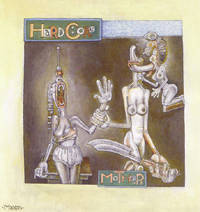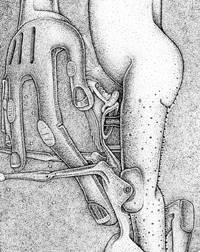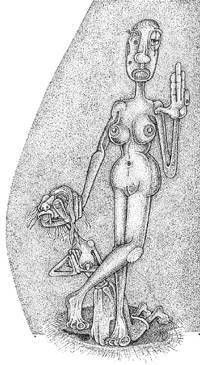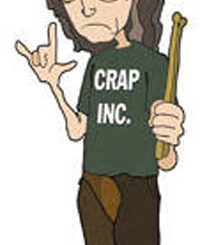 Underground Station
Underground Station
by Bruce Sweeney
I finally got my copy of Sherlock Holmes Strangest Cases in which Wordplay (1 Sutter St. Suite 205 San Francisco, CA 94104) merges underground cartoonist/illustrator/lecturer Spain with Sir Arthur Conan Doyle’s original detective format. We could’ve used more Spain. His cover is minimal, with virtually no background. T’ain’t much content, either. It’s 116 pages, including the illustrations, which number eight. The signed and numbered version, however, is worth the $48. With a mere 225 copies available, this should stir interest in the underground artist/specialty book market.
Spain’s work is underrepresented in book form; a few soft cover titles like Trashman and few enough illustrated books like this. What Wordplay does well is synchronize extraordinary period writers (Grimm, Poe, etc.) with hip, distinctive illustrators who have graduated from the underground comix. It’s a high point in editing. The print standards are high, and the editing and presentation are snappy and appealing.
 There will always be a few books in this genre; the slightly hip, obscure, new beat-off island illustrated combination of offbeat poetry, or science fiction short stories, or fresh ground-breaking fiction. Imagine three strong underground illustrators like Spain, Charles Burns, and Art Speigelman collaborating. Imagine them doing an illustrated trilogy of emerging young science fiction writers, or jamming on a triple tribute to The Doors, or illustrating unpublished Iggy Pop lyrics. It all sounds droolable to me.
There will always be a few books in this genre; the slightly hip, obscure, new beat-off island illustrated combination of offbeat poetry, or science fiction short stories, or fresh ground-breaking fiction. Imagine three strong underground illustrators like Spain, Charles Burns, and Art Speigelman collaborating. Imagine them doing an illustrated trilogy of emerging young science fiction writers, or jamming on a triple tribute to The Doors, or illustrating unpublished Iggy Pop lyrics. It all sounds droolable to me.
There will be sub-niches of this stuff. Just like some people collect bootleg tapes of killer guitarists, memorabilia from the Star Trek community, or obscure movie posters, these odd-batch books that shift past us like water in a slow river will eventually become hot as late-20th century/early 21st century material. You heard it here first…
A shake-of-the-Head Item-of-the-season is Maxon Crumb’s Hardcore Mother Drawing A to Z. This book is too too… Maxon Crumb is the brother of American-cartoonist-gone-to-France, Robert Crumb. Maxon showed up in the movie Crumb as one of Robert’s crazier brothers. He’s the one who did not commit suicide and was discovered in the underbelly of San Francisco’s down and out Tenderloin section. Someone found his artwork arresting and insane enough to publish. Maxon illustrated a book of stories by Edgar Allen Poe for San Francisco’s Cottage Classics in 1997. As an artist, he’s unique, mad, and very detailed in his approach. He’s geometric; with tons of squares and angles, but his vision is wildly distant and unintimate. We’re richer to have him with us as an illustrator. Isn’t there enough room for one more occasional illustrator with a personal vision?
This summer will find me back in Jolly Olde (England, ya dummy), and being on my own for a few days will try to link up with the English illustrator Hunt Emerson, who’s a great underground cartoonist. Check out his stuff on the Internet through his Large Cow site. After I see him, I’ll visit old friend Bryan Talbot, another terrific artist with a great capacity to blend alternative history and science fiction. Ten books on a lost island would have to include his Adventures of Luther Arkwright.
 Randall Holmes died March 15 (also reported in some sources as March 22). He was 60 years old and died in Nanaimo, B.C. while awaiting chemotherapy treatment for Hodgkin’s lymphoma. I am incapable of recapping someone’s creative life, but he made an enormous contribution to underground comics. His style was very reminiscent of the early seminal E.C. comics artists like Jack Davis and Wally Wood. He was largely reclusive and was never a limelight figure. His Adventures of Harold Hedd was a terrific marijuana smuggler story and his Fog City Comics had a friend and I howling with laughter all over again just two weeks ago. He contributed great material to Gay Comics, Death Rattle, and even recently to Baseball Comics. Kitchen Sink Comics often found room for him. He was magnificent; always showing up on my top ten list. Now, where there was never enough of him, there will be no more.
Randall Holmes died March 15 (also reported in some sources as March 22). He was 60 years old and died in Nanaimo, B.C. while awaiting chemotherapy treatment for Hodgkin’s lymphoma. I am incapable of recapping someone’s creative life, but he made an enormous contribution to underground comics. His style was very reminiscent of the early seminal E.C. comics artists like Jack Davis and Wally Wood. He was largely reclusive and was never a limelight figure. His Adventures of Harold Hedd was a terrific marijuana smuggler story and his Fog City Comics had a friend and I howling with laughter all over again just two weeks ago. He contributed great material to Gay Comics, Death Rattle, and even recently to Baseball Comics. Kitchen Sink Comics often found room for him. He was magnificent; always showing up on my top ten list. Now, where there was never enough of him, there will be no more.
Top Shelf, the independent comic publisher, nearly collapsed. A major, unnamed distributor handed them a huge check that bounced and they nearly went under. They sent out a plea to customers for strong orders to keep them afloat. Somehow, they managed to keep on top with some help from elsewhere, but allegedly it was touch and go for a while…
I’m relieved, of course. They have a host of contributors like Steve Lafler that do cutting edge work which could’ve been lost forever had they not maintained their balance. How much art and music gets lost to us because a benefactor cannot come through? One of the best working blues harmonicas is William Clark. He had to hold onto a factory job until 40 when he could finally turn professional. He lost out, we lost out, and when you stop to consider, the woods are filled with stories like that.



